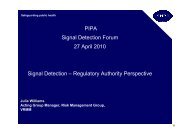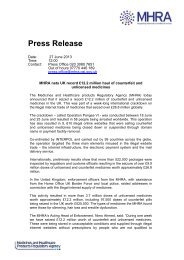Signal Detection Standards - Pipa
Signal Detection Standards - Pipa
Signal Detection Standards - Pipa
- No tags were found...
Create successful ePaper yourself
Turn your PDF publications into a flip-book with our unique Google optimized e-Paper software.
07PIPA Guidelines for <strong>Signal</strong> Management1.3 <strong>Signal</strong> <strong>Detection</strong> MethodsThe common signal detection methods that can beused include:1.3.1 Qualitative 6Case-by-case manual review of individual casereports (a single case, in some rare instances, mayconstitute a signal). A human assessor reviews linelistings or individual CIOMS forms for a given period.No comparison is made with cumulative data.1.3.2 Quantitative 6Quantitative signal detection utilises statisticalmethods to identify drug-event pairs (or frequentcombinations of a drug and an event) thatoccur with disproportionately high frequencyin large spontaneous report databases. Typicalmethodologies used include the ProportionalReporting Ratio (PRR) or the Empirical BayesianGeometric Mean (EBGM).It should be noted that this method may identify asignal of disproportionate reporting which does notnecessarily indicate there is a signal to be furtherinvestigated or that a causal association is present 7 .Limitations regarding the use of quantitativemethods for small and medium sized companiesinclude:CostComplexityIncreased risk of false positive signals insmall datasetsObtaining results not representative of generaladverse drug reaction reporting (due to overrepresentation of a particular therapeutic area in asmaller database)Lack of access to a large diverse reference datapool (representing the background noise).1.4 Simple-Quantitative<strong>Signal</strong> <strong>Detection</strong>This method may include review of CIOMSII line listings and frequency tabulations. Itis important to not only use periodic linelistings for signal detection, but to also includecumulative tabulations to assess changes infrequencies of events from a period as comparedto your overall safety database background.As a minimum, a medical review of these listingsshould be considered. It is also suggested that theQPPV reviews these listings. These persons do nothave to produce the listings.To review data from the safety database for eachactive substance you may wish to run a minimum ofthree listings:Period frequency summary tabulationCumulative summary tabulation 8Period CIOMS II line listing.Summary tabulations may include the absolutenumber and relative proportions of events.For each active substance, review summarytabulations to identify clusters of events. Thisshould be at the most appropriate MedDRAlevel decided by your company e.g. PreferredTerm (PT) or System Organ Class (SOC) level.If your period line listing has identified nocases, ensure this is documented e.g. in yoursignal detection review meeting minutes.Remember to review data captured outsidethe database when available e.g. reviewMS-Excel® tracker for non-valid cases.Now that signal detection has been completed youwill need to consider prioritising how to review thesignals you have detected.1
08PIPA Guidelines for <strong>Signal</strong> Management2<strong>Signal</strong>PrioritisationGiven the number of signals produced, smallercompanies may not need to prioritise signals for aparticular product, choosing instead to assess alldetected signals. However, for most companies aprocess for prioritisation of these signals is required.<strong>Signal</strong> prioritisation is a critical part of the signalmanagement process.For small and medium sized companies, assessingall signals in detail is resource intensive because ofthe high number of false positive signals. Prioritisingallows action to be taken more expeditiously forhigher priority signals than for other signals.Larger companies may consider adopting anapproach similar to the MHRA Impact Analysis forsignal prioritisation, where the impact of a signal issummarised through two scores 9 :For small and medium companies a moreinformal approach using the factors above canbe used (CIOMS VIII 11 ) as long as this is justifiedand documented. You may also want to considerprioritising using one or more of the “always serious”lists below:“Always Serious” ADRs and Designated MedicalEvents (see definitions).Other examples:– CIOMS V 12– EMA Important Medical Events list 13Finally, consider using expectedness as part ofyour prioritisation.Quality of the evidence (strength of evidence forcausality e.g. Bradford-Hill Criteria) 10Public health impact of the signal.The MHRA impact analysis produces a four-levelcategorisation which leads to a proposal for furtheraction from high priority signals which need furtherassessment to the lowest priority signals whichrequire no immediate action (e.g. may either beclosed or require further monitoring only).
09PIPA Guidelines for <strong>Signal</strong> Management<strong>Signal</strong>Assessment33.1 <strong>Signal</strong> AssessmentStrategies3.2 Decision MakingFollowing AssessmentAfter a signal is prioritised, other sources of datashould be systematically assessed to determinewhether sufficient evidence of causality exists, andwhat further action, if any, may be required.Sources of evidence include:The individual case safety report(s) (ICSR(s))that triggered the signalOther ICSRs with similar event termsidentified e.g. by using StandardizedMedDRA Queries (SMQs ) 14Scientific literatureClinical trial and pre-clinical dataEpidemiological data 15 .The use of SMQs is recommended in order toretrieve and review similar cases of interest whenpotential signals are identified within a database.In practice many signals can be assessed on thestrength of the ICSRs triggering the signal. Criteria toconsider when reviewing a signal from a case seriesare provided in CIOMS VIII 16 .Depending on the case load (number / volumeof cases), the data may be stratified according toage, gender, ethnicity, concomitant medication ordisease. This may identify populations at highest riskfor the event and also reduces confounding 2 .A judgement about whether a signal is validateddepends on the number and quality of case reports,the nature of the reaction, type of drug and thepopulation exposure 7 .There are three possible options followingsignal assessment:Close signalThe signal was refuted based on the availableevidence and no further action is required. Thedecision and rationale for closing a signal shouldbe documented. However, if further evidencebecomes available the signal can be re-assessed.Continue monitoringIn some circumstances a decision cannotbe made until the evidence supporting thesignal is strengthened. Except for situations ofextreme risk, these signals are monitored untilsufficient evidence becomes available to eitherconfirm or refute the signal. The decision andrationale to justify monitoring a signal should bedocumented.Take further actionAfter a signal is validated further action isrequired. The decision and rationale to takefurther action for a signal should be documented.The actions may include the following 17 :Notify the Qualified Person forPharmacovigilance (QPPV)Enhanced monitoring or follow-up techniquesConsult internal or external expertsTargeted clinical investigationsComparative observational studiesActive surveillance schemesClinical trials.
10PIPA Guidelines for <strong>Signal</strong> Management4StakeholderCommunicationIf there is a change in the benefit-risk profile as aresult of a validated signal the following actionsshould be considered:Within your company (according to internalprocedures):Notify your QPPV (if they have not been involvedin the signal validation process)Escalate within the global safety function (ordepartment) (if applicable)Discuss with other company departments,especially the regulatory departmentCollate a safety data package relating to thevalidated signalThe QPPV (or appropriate delegate) will workwith the regulatory department to communicatewith the regulatory authorities, as appropriateCommunicate with regulatory authoritiesIf a signal is being monitored, but has not beenvalidated, it may be useful to describe this inPSURs and RMP updates, where applicable.After confirmation of a signal the following actionsmay be initiated:Variation of the Summary of medicinal ProductCharacteristics (SmPC) and Product InformationLeaflet (PIL)Revision of the RMP (if applicable)Provision of safety information directly to HCPs(including clinical trial investigators, whereappropriate) / patients or the public, for examplethrough letters or the company’s website.Product recallMA withdrawal.Some of these actions may require notifying thecompetent authorities first, e.g. in the case ofprovision of safety information to HCPs/patients/the public.
11PIPA Guidelines for <strong>Signal</strong> ManagementOther Issues 55.1 SOPs / Documentation5.3 QualityIn addition to the signal detection SOP, signaldetection documentation, such as agendasand meeting minutes must adequately captureall decisions and subsequent actions. Thesemay be reviewed at an audit or regulatoryauthority inspection.<strong>Signal</strong> detection and signal management are partof the pharmacovigilance system and thereforeshould be included in any internal companypharmacovigilance systems audit.5.2 Tracking of <strong>Signal</strong> andMeeting ActionsActions and signals should be tracked over aperiod of time e.g. open signals, implementationof agreed actions for a validated signal and time toresolution of signal, to provide a visible audit trail 18 .This is particularly important wherethere may be a history with a signal overtime (and over several signal detectionmeetings), involving multiple decisions.
13PIPA Guidelines for <strong>Signal</strong> ManagementReferences1. PIPA PV Glossary. http://www.pipaonline.org/membersarea/pv_glossary.jsp2. Guideline on Good Pharmacovigilance Practice. Module IX – <strong>Signal</strong> Management. European MedicinesAgency (2012).3. Council for International Organisations of Medical Sciences (CIOMS) WG VIII, Practical Aspects of <strong>Signal</strong><strong>Detection</strong> in Pharmacovigilance (2010). pg 116.4. Council for International Organisations of Medical Sciences (CIOMS) WG VIII, Practical Aspects of <strong>Signal</strong><strong>Detection</strong> in Pharmacovigilance (2010). Appendix III, pgs 121 – 135.5. Guideline on Good Pharmacovigilance Practice. Module VI - Management and reporting of adversereactions to medicinal products. European Medicines Agency (2012).6. Council for International Organisations of Medical Sciences (CIOMS) WG VIII, Practical Aspects of <strong>Signal</strong><strong>Detection</strong> in Pharmacovigilance (2010). pg 113-114.7. Guideline on Good Pharmacovigilance Practice. Module IX – <strong>Signal</strong> Management. European MedicinesAgency (2012). Section B.3.2.2.8. ICH E2C(R2) Guideline on the Periodic Benefit-Risk Evaluation Report (PBRER).9. Waller P, Heeley E, Moseley J. Impact Analysis of <strong>Signal</strong>s Detected from Spontaneous Adverse DrugReaction Reporting Data. Drug Safety. 28(10):843-850, 2005.10. Bradford-Hill A. The Environment and Disease: Association or Causation? Proceedings of the Royal Societyof Medicine 58: 295–300, 1985.11. Council for International Organisations of Medical Sciences (CIOMS) WG VIII, Practical Aspects of <strong>Signal</strong><strong>Detection</strong> in Pharmacovigilance (2010). Pg 89 Table 9.12. Current Challenges in Pharmacovigilance: Pragmatic Approaches (Report of CIOMS Working Group V).http://www.cioms.ch/publications/frame_available_publications.htm13. Eudravigilance EMA Important Medical Event (IME) terms list http://eudravigilance.ema.europa.eu/human/textforIME.asp14. Council for International Organisations of Medical Sciences (CIOMS). Development and rational use ofStandardised MedDRA Queries (SMQs). Geneva: CIOMS; 2004. Available on CIOMS websitehttp://www.cioms.ch/15. Council for International Organisations of Medical Sciences (CIOMS) WG VIII, Practical Aspects of <strong>Signal</strong><strong>Detection</strong> in Pharmacovigilance (2010).Pg 92.16. Council for International Organisations of Medical Sciences (CIOMS) WG VIII, Practical Aspects of <strong>Signal</strong><strong>Detection</strong> in Pharmacovigilance (2010). Pg 91 Table 11.17. Council for International Organisations of Medical Sciences (CIOMS) WG VIII, Practical Aspects of <strong>Signal</strong><strong>Detection</strong> in Pharmacovigilance (2010). Pg 93 Table 12.18. Guideline on Good Pharmacovigilance Practice. Module IX – <strong>Signal</strong> Management. European MedicinesAgency (2012). Section B.4.1.
14PIPA Guidelines for <strong>Signal</strong> ManagementThese guidelines were developed by thePIPA <strong>Signal</strong> <strong>Detection</strong> Working Partywww.pipaonline.org/membersarea/signaldetection.jsp
© Pharmaceutical Information andPharmacovigilance Association 2012For the current version of this document, pleaseconsult the PIPA website (www.pipaonline.org)
PIPAPO Box 254HaslemereSurreyGU27 9AF







